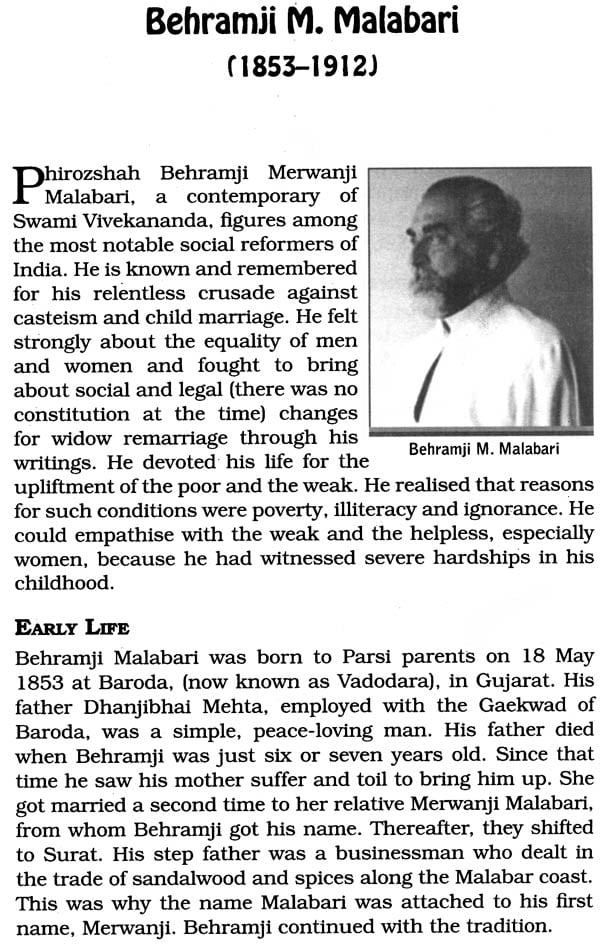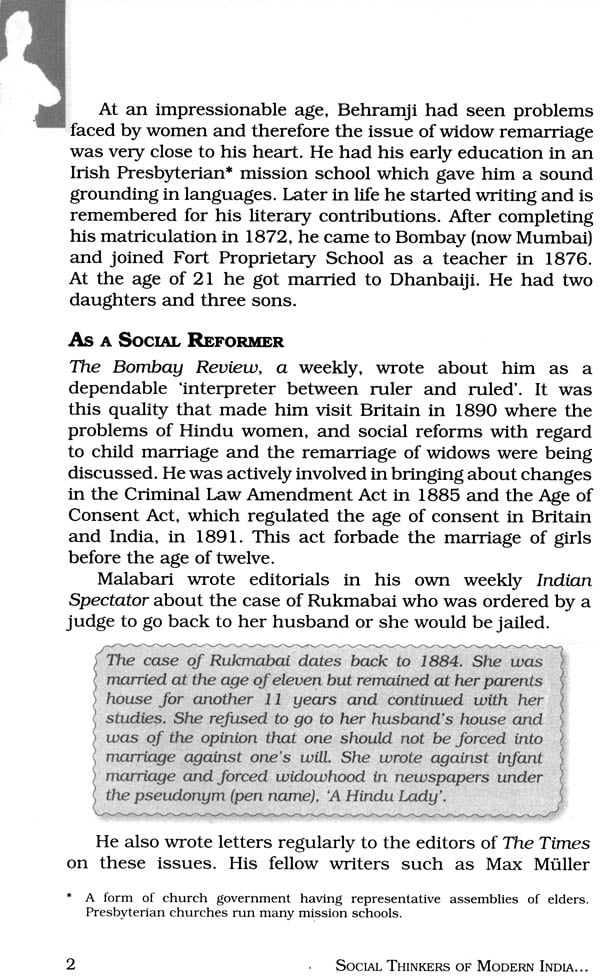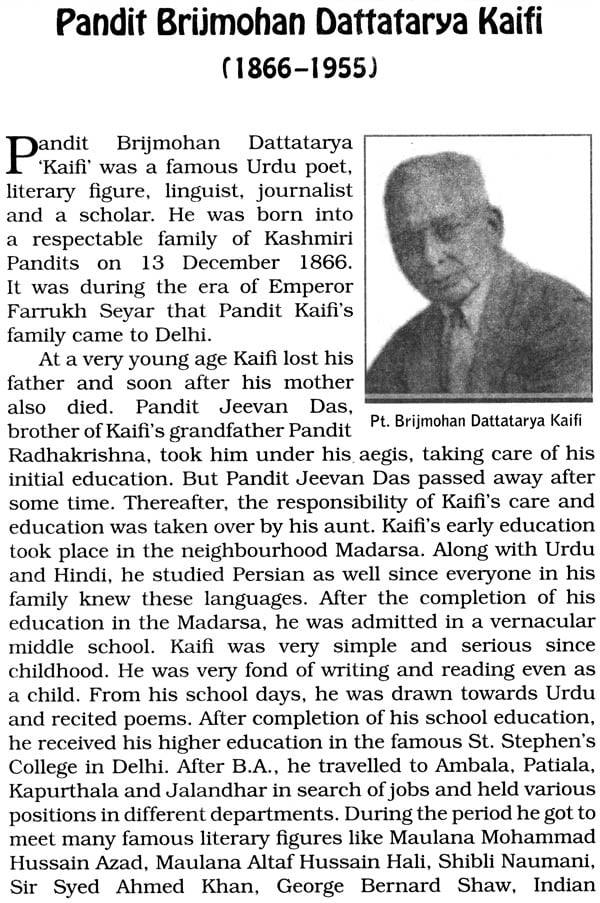
Social Thinkers of Modern India (Contemporaries of Swami Vivekananda)
Book Specification
| Item Code: | NAM843 |
| Publisher: | National Council of Educational Research and Training |
| Language: | English |
| Edition: | 2014 |
| ISBN: | 9789350072950 |
| Pages: | 76 (17 B/W Illustrations) |
| Cover: | Paperback |
| Other Details | 9.5 inch X 6.5 inch |
| Weight | 130 gm |
Book Description
The National Council of Educational Research and Training (NCERT) has prepared the present compilation in commemoration of the 150th birth anniversary of Swami Vivekananda. Swamiji said, "we want that education by which character is formed, strength of mind is increased, the intellect is expanded and by which one can stand on one's own feet." This reveals Swamiji's great emphasis on holistic education.
Swamiji was influenced by several thinkers and, in turn, influenced many great thinkers. This book contains sketches of thirteen such thinkers of modern India. Efforts have been made to present them in a manner that would interest our young readers, and would help them relate to the issues brought out through these biographies.
These brief biographies have been created with the hope that they would help the readers understand the contribution towards development of a society which would practise equality and coexistence. Their efforts resulted in a series of social reforms, creating awareness through many means, but largely through education.
The National Council of Educational Research and Training appreciates the work done by the faculty in creating this Supplementary Reader. I wish to thank Professor Kumkum Roy for doing a fine job of editing this booklet.
Finally, dear readers, there are several other such people who may have lived in your locality or district or state in recent times. You may like to pen down their biographies, and share your writings with your friends and us. Please do write to the coordinator of this book, giving your views on this book.
The social science textbooks developed by the National Council of Educational and Training (NCERT), as a follow up to National Curriculum Framework (NCF) – 2005, refer to the life and thoughts of several great thinkers of modern India and the world from different walks of life. The themes in the books are woven around issues of contemporary concern and span various disciplines like history, geography, economics, and social and political studies. Nothing can be more inspiring for a student than the lives, work and vision of those great personalities who have shaped the changes that our country has witnessed across the past century and half. Access to supplementary reading materials on diverse issues and eminent personalities can greatly enhance the teaching-learning process. It has, therefore, been felt worthwhile to develop a volume of short essays on 13 such representative personalities who have contributed significantly to shaping India as we know her today.
Swami Vivekananda was born in an affluent family in Kolkata on 12 January 1863. He is one such iconic figure who represented the spirit of India overseas. Also, the reawakening of India in the second quarter of the nineteenth century was heralded by the reformation works of several eminent personalities like Raja Ram Mohan Roy who founded the Brahmo Samaj in 1828. Keshab Chandra Sen who founded the Prarthana Samaj in 1867. Mahadev Govind Ranade under whose guidance the Deccan Education Society was founded in 1884. Gopal Krishna Gokhale who founded the Servants of Indian Society in 1905. Jyotiba Phule who founded the Satya Shodhak Samaj in 1873. Swami Dayananda Saraswati who established the Arya Samaj in 1875, Annie Besant who led the Theosophical Society, Henry Louis Vivian Derozio who encouraged the youth through the Young Bengal Movement, Sayyid Ahmad Khan who led the Aligarh Movement and Dadabhai Naoroji who played a distinguished role in the social regeneration of the Parsis and the overall political regeneration of India.
Beginning their journey for power in India from the south, the British brought the whole country under their subjugation by the middle of the nineteenth century. The British Empire in India was converted into the British Empire of India not only through policies such as the 'Subsidiary Alliance' and the 'Doctrine of Lapse' by which the power and independence of the native princes were effectively neutralised but also through such debilitating economic, religious, cultural and educational policies. And by 1857, the boundaries of that mighty political entity were touching the Hindukush on one side and Burma on the other covering in between the entire landmass from the Himalayas to Cape Comorin.
Political unification brought about by a foreign power had its own woes, but it afforded Indians a basis to wake up as a nation, fight against colonial oppression and win freedom for themselves. To rekindle the spirit of India in such times Swami Vivekananda drew inspiration from the teachings of his Guru, Sri Ramakrishna Paramahamsa (1836-1886) and also established a monastic order which endures to this day as the Ramakrishna Mission.
Sri Ramakrishna Paramahamsa regarded all forms of worship as the adoration of one Supreme Being and all religions as different paths leading to the same goal. Swami Vivekananda combined the teachings of Sri Ramakrishna Paramahamsa with his brilliantly poised modern outlook and presented them with the rest of the world. After hearing him in the World Parliament of Religion in Chicago the New York Herald reported, " ... how foolish it is to send missionaries to this learned nation". Indeed, Swami Vivekananda was the first Indian who re-established the spiritual eminence of the Vedanta philosophy on a global scale. On 11 September 1893, in the opening session of the Parliament of Religions, he had said: "As the different streams having their sources in different places all mingle their water in the sea, so, O Lord, the different paths which men take, through different tendencies, various though they may appear, crooked or straight, all lead to Thee." Again, striking a similar chord in the final session of the Parliament on 27 September 1893, he professed: "If the Parliament of Religions has shown anything to the world, it is this: It has proved to the world that holiness, purity, and charity are not the exclusive possessions of any church in the world, and that every system has produced men and women of the most exalted character. In the face of this evidence, if anybody dreams of the exclusive survival of his own religion and the destruction of others, I pity him from the bottom of my heart and point out to him that upon the banner of every religion will soon be written, in spite of resistance: 'Help and not Fight', 'Assimilation and not Destruction', 'Harmony and Peace and not Dissension'."
On 'religion' itself the Swamiji's views were quite radical for his time. As he once told to his western audience in America: "You must bear in mind that religion does not consist in talk, or doctrines, or books, but in realisation. It is not learning but being." He thus emphasised upon 'morality' as the basis of spiritual life. On his second visit to America he said, "What do I care if Mohammed was a good man, or Buddha? Does that alter my own goodness or evil? Let us be good for our own sake on our own responsibility." Later in India he would often emphasise on doing good work and say, "In every country, nations have their good and bad sides. Ours is to do good work in our lives and hold an example before others ... In this world of maya, whatever work you take up will be attended with some defect. 'All undertakings are beset with imperfections, as fire with smoke' (Gita, 18.48). But will you, on that account, sit inactive? As far as you can, you must go on doing good work."
However, Swamiji's mission was not simply to talk of religion. He had travelled through the length and breadth of India, mostly on foot, visiting places of history and pilgrimage and in that process had also seen people living in miserable poverty. He too had suffered a good deal of poverty himself. His guru Sri Ramakrishna Paramahamsa had said, " ... religion was not for an empty stomach". In fact, as he would confide later, one of his reasons to travel to America was to seek the help of American people to ameliorate the situation of ordinary Indians in exchange for his teachings of the Vedanta there.
Swami Vivekananda truly believed that any reform could be successful only by uplifting the masses. Therefore, his clarion call to the people of India was to rise above the narrow confines of their religion of the kitchen and come together in the service of the nation. His consistent call to Indians was to "Arise! Awake! And stop not till the goal is reached!" By sending out this call, Swami Vivekananda made a significant contribution to the nascent nationalism of India. His exhortation to the youth was to unite on the basis of a common spiritual heritage. In this exhortation he became truly 'the symbol of a new spirit and a source of strength for the future'.
Today all of us take pride in being Indians. Ours is the largest democracy in the world and we have made great progress economically. Nature too has blessed us with ample natural resources. These very qualities could have led peoples and pilgrims, traders and travellers, and armies and adventurers to this country, including the British.
Several other great men and women, who are seldom mentioned in dominant national narratives, have contributed immensely to the regeneration of India during the late nineteenth and early twentieth century and must not be forgotten. Inspired by Swami Vivekananda these individuals and their works are a fitting tribute to his legacy of propagating the process of wider social reform in the country.
This Supplementary Reader is thus conceived as a means to foreground these great thinkers and doers of modern India. It is our sincere hope that this volume will be of value to both students and teachers. The reader friendly volume will also be an addition to NCERT's existing repertoire of pedagogically innovative productions that always seek to provide students with engaging and sound material to enrich their learning experience.
| Foreword | iii | |
| Preface | v | |
| 1 | Behramji Malabari | 1 |
| 2 | Cornelia Sorabji | 7 |
| 3 | Gijubhai Badheka | 10 |
| 4 | Gunabhiram Barua | 17 |
| 5 | Ishwar Chandra Vidyasagar | 23 |
| 6 | Kadambini Ganguly | 28 |
| 7 | Madhusudan Das | 31 |
| 8 | Pandita Ramabai | 37 |
| 9 | Pandit Brijmohan Duttatarya Kaifi | 42 |
| 10 | Rajkumari Amrit Kaur | 46 |
| 11 | Sir Syed Ahmad Khan | 51 |
| 12 | Sister Nivedita | 56 |
| 13 | Subramanya Bharati | 62 |









